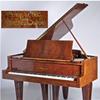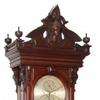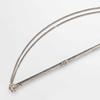Major Monet Exhibition Will Reopen in Germany with New Protective Measures for Museum Visitors
- April 29, 2020 19:42
Following guidelines set by the Brandenburg Museum Association, Museum Barberini in Potsdam will reopen on May 6, after two months of temporary closure due to COVID-19 precautions in Germany. Pre-booked tickets for the museum's Monet exhibition remain valid, and tickets will be available online, with visitors subject to an extensive list of protective and hygiene measures. Monet: Places will be extended to July 19, 2020.
Visiting slots will be limited to 120 minutes, and a sign-posted tour will help visitors to abide by the 1.5-meter social distancing rule. The compulsory wearing of masks and a general contact reduction will further enhance protection. Lockers and audio guide devices will not be given out, but a Barberini App audio tour will be available for smartphones. There will be no group tours. (A virtual tour is available, too. Or, take a peek at the sold-out iteration of the show previously at Denver Art Museum.)
Ortrud Westheider, Director of the Museum Barberini, points out: “We are delighted to finally make the museum accessible again. We are conscious of the responsibility we have to our guests and staff. In these difficult times, during which museums all over the world were closed, the Museum Barberini has experienced extraordinary solidarity: Within a very short time, our numerous international lenders agreed to extend the exhibition Monet: Places, thus enabling us to devote time and space to Monet’s work.”
With 120 minutes and less people around, museum visitors will perhaps have more of their own time and space to devote to Monet and his places.
Featuring key loans, the exhibition, which traveled from Denver Art Museum, explores Monet's approach towards the depiction of sites and topographies that influenced his stylistic development, including Paris and London, the Seine villages of Argenteuil, Vétheuil and Giverny, the coasts of Normandy and Brittany as well as Southern travel destinations such as Bordighera, Venice and Antibes. Amongst the show’s many highlights are numerous depictions of Monet’s garden and pond in Giverny, including several variations of his world-famous waterlilies.
At the very heart of Monet’s artistic practice lay a keen interest in capturing the impression of a fleeting moment, as he tried to translate the most evanescent effects of the atmosphere into the material structure of paint. “For me, a landscape does not exist in its own right, since its appearance changes at every moment”, Monet explained in 1891. “But its surroundings bring it to life – the air and light, which vary continually (…). For me, it is only the surrounding atmosphere which gives objects their real value.”
Daniel Zamani, curator at the Museum Barberini, explains: “Monet’s career has been the subject of intense scholarly scrutiny, but our focus on the places that inspired him offers new insights into his artistic interests and methods. Our aim is to demonstrate just how significant specific topographies were at key junctures in Monet’s career and to look more deeply into how and why these places influenced his development as a painter.”
A richly illustrated catalogue is available.





















